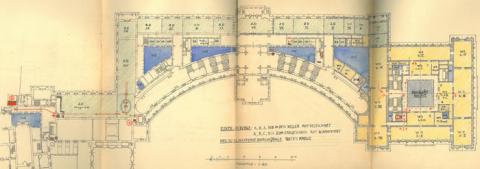The Central Depot was established in autumn 1938 to store objects from seized Vienna art collections whose owners were persecuted as Jews. It was initiated by the provisional director of the Kunsthistorisches Museum (KHM) in Vienna Fritz Dworschak, who sought to bring the art and cultural objects stored until then in different places under one roof. Walter Stahlecker, head of the Vienna Sipo (security police) ultimately ceded to Dworschak's repeated demand to have the depot installed at the expense of the Kunsthistorisches Museum on the first floor of the Neue Burg. It contained art objects from the collectors Emmi Aldor, Bernhard Altmann, Alois Bauer, Oscar Bondy, Leo Fürst, David Goldmann, Rudolf Gutmann, Felix Haas, Felix Kornfeld, Moritz Kuffner, Wally Kulka, Otto Pick, N. Pilzer, Valentin Viktor Rosenfeld, Alphonse Rothschild, Louis Rothschild and Alfons Thorsch as well as objects of unknown origin, some displayed in the rooms, others packed in crates. Under the direction of Leopold Ruprecht, director of the Imperial Armoury at the Kunsthistorisches Museum, and with the assistance of other state museums (Heinrich Leporini / Albertina, Ignaz Schlosser / State Arts and Crafts Museum in Vienna) the objects were catalogued and extensively photographed. A provisional inventory in summer 1939 – without coins and medals – listed around 8,000 objects. The power of disposal of the stored objects lay with Hitler, as they were reserved for his planned museum in Linz ("Führervorbehalt"). Hans Posse, who was in charge of the Linz project, selected the objects earmarked for the museum. The remaining objects were then distributed among interested museums, which presented comprehensive lists. Friedrich Plattner, State Commissar for Education, Culture and Popular Education and head of Department III of the Office of the Reichsstatthalter, was commissioned in September 1939 by Gauleiter Josef Bürckel to administer the seized objects. The Kunsthistorisches Museum was removed as manager of the Central Depot and replaced in July 1940, with the authorization of the Reich Chancellery, by the provisional director of the art history department of the Institute for Monument Preservation Herbert Seiberl. At the same time this took away the authority of Dworschak, who had been at pains to ensure that his museum benefitted well from the distribution of his authority. At the start of the war, the first items from the Central Depot were already being salvaged, and from 1941 it was gradually emptied as the objects were shipped elsewhere, for example, to Reich Art Depot in the dissolved abbey at Kremsmünster. Residual items from the Central Depot were found in the Neue Burg during a visit in May 1945. Many but by no means all of the seized objects were returned to their original owners after the war. The whereabouts of some items, particularly interior furnishings, was unclear. In return for issuance of export authorization for the remainder of the collections, the Austrian federal museums in the second half of the 1940s demanded that selected art objects be handed over to them. These were not restituted until the Art Restitution Act of 1998. The card indexes of the Central Depot for Seized Collections held in the archives of the Federal Monuments Authority and Kunsthistorisches Museum and the annotated catalogue of the KHM archive therefore represent important sources for systematic identification of the fate of the objects. They were published for the first time by the KHM and Commission for Provenance Research in an online edition in December 2017.
Zentraldepot für beschlagnahmte Sammlungen

Online card index of the Central Depot for Seized Collections in Vienna: www.zdk-online.org/en.
Theodor Brückler (Hg.), Kunstraub, Kunstbergung und Restitution in Österreich 1938 bis heute, Wien-Köln-Weimar 1999.
Digitalisierung und Online-Publikation der Zentraldepotkartei(en), in: Kunsthistorisches Museum Wien, URL: www.khm.at/erfahren/forschung/forschungsprojekte/historische-projekte/digitalisierung-und-online-publikation-der-zentraldepotkarteien/ (3.12.2020).
Herbert Haupt, Jahre der Gefährdung. Das Kunsthistorische Museum 1938–1945, Wien 1995.
Herbert Haupt, Die Rolle des Kunsthistorischen Museums bei der Beschlagnahme, Bergung und Rückführung von Kunstgut in den Jahren 1938–1945, in: Theodor Brückler (Hg.) Kunstraub, Kunstbergung und Restitution in Österreich 1938 bis heute, Wien-Köln-Weimar 1999, 53–75.
Herbert Haupt/Franz Pichorner, Zehn Jahre Provenienzforschung im Kunsthistorischen Museum, in: Gabriele Anderl/Christoph Bazil/Eva Blimlinger/Oliver Kühschelm/Monika Mayer/Anita Stelzl-Gallian/Leonhard Weidinger (Hg.), ... wesentlich mehr Fälle als angenommen. 10 Jahre Kommission für Provenienzforschung (= Schriftenreihe der Kommission für Provenienzforschung 1), Wien-Köln-Weimar 2009, 136–149, URL: doi.org/10.7767/boehlau.9783205118862.136.
Birgit Schwarz, Hitlers Sonderauftrag Ostmark. Kunstraub und Museumspolitik im Nationalsozialismus (= Schriftenreihe der Kommission für Provenienzforschung 7), Wien-Köln-Weimar 2018, doi.org/10.7767/9783205206965.
Online-Edition der Karteien zum sogenannten Zentraldepot für beschlagnahmte Sammlungen in Wien, URL: www.zdk-online.org (3.12.2020).
BDA-Archiv, Restitutionsmaterialien: K. 8, M. 1, M. 3, M. 7, M. 10; K. 50/3; Zentraldepotkartei, Alphonse Rothschild, 1–546, 547–1300, 1301–2100, 2101–2900, 2901–3564; Zentraldepotkartei, Louis Rothschild, 1–500, 501–964; Zentraldepotkartei, Rudolf Gutmann, 1–887; Zentraldepotkartei, Diverse.
KHM-Archiv, 25/KL/1940; 238/KL/1938; 255/KL/1938; 275/KL/1939; 25/KL/1940; I 52, 6/WS/1942; XIII 68; XIII 69; XIII 70; XIII 71; XIII 75.; XIII 76; XIII 77; XIII 78; XIII 79; XIII 80.
